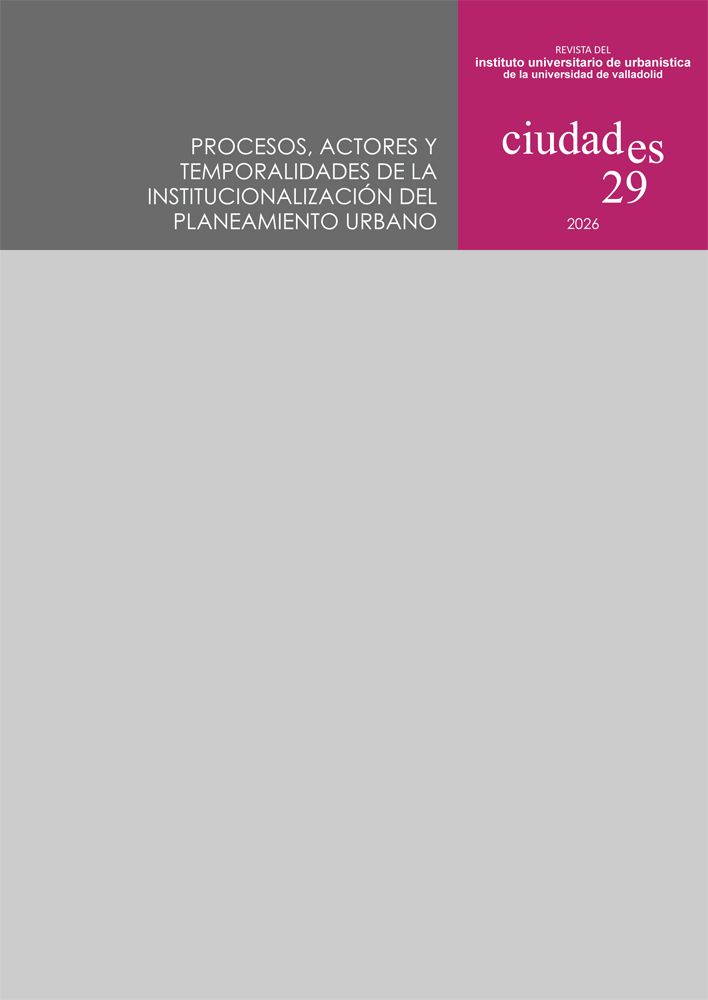Processes, actors and temporalities of the institutionalisation of urban planning. On the seventieth anniversary of the 1956 Spanish Land Law
Ciudades 29, 2026
The Land and Urban Planning Law of 1956 (LS 1956) was the first Spanish urban planning code and imposed the principles and instruments for systematic land use planning. It was, therefore, an important step in the modernisation of urban planning legislation and in the application of urban planning, to which Spanish professionals, in tune with international thinking and economic and social issues, had been aspiring since the late 1920s. This issue of the journal Ciudades aims to take advantage of the opportunity provided by the seventieth anniversary of its approval to examine and examine in depth the institutionalisation of urbanism and urban planning, understanding it, in the sociological sense, as a process by which a phenomenon emerges and takes hold in a social group or in a society as a whole, that is, how it takes shape through the reflections, discourses and practices of individuals and the group to become part of reality.
The LS 1956 and the promotion, between 1949 and 1956-1957, of a General Directorate of Urban Planning were obviously important milestones in the process of the introduction and establishment of modern urban planning in Spain, marking its entry into the State apparatus and the start of a national urban planning policy. But the process of institutionalisation of urban planning was not limited to that moment, as it encompassed a broader sequence, including earlier and later stages. Thus, the 1940s saw the emergence of a series of supra-municipal administrative bodies –Gran Bilbao, Gran Valencia, Provincial Urban Planning Commissions, etc.– and special laws approving general urban development plans, such as that of Madrid. They formed part of a phase of practical, administrative and legal experimentation in urban and regional planning, on which the drafters of the LS 1956 based themselves, without forgetting the precedents prior to 1939. Likewise, in the years following its enactment, a number of regulations implementing the law and bodies such as the Gerencia de Urbanización (1959), dedicated to land preparation, came into operation with greater or lesser ease.
Institutionalisation is, therefore, a concept that allows us to observe the genesis and existence of an organisation, rule or practice recognised by the social body, but it also includes the study of the way in which these ‘institutions’ are maintained and updated –or not– over time and up to the present day, depending on political, economic or social evolution. The return of democracy after Franco’s death did not entail the questioning of the legal framework of urban planning and urban planning practice defined during his dictatorship. Despite several reforms, these have remained largely unchanged up to the present day, even if altered by the decentralisation of the 1980s, the land liberalisation measures adopted at the end of the 1990s, etc. Thus, the LS 1956, and its important reform approved in 1975, was an obvious source of inspiration for the urban planning laws introduced by the Autonomous Communities in the 1990s and 2000s. Consequently, many of the rules, procedures and spatial planning practices that LS 1956 helped to introduce are still very much in force, despite the time that has elapsed and the succession of changes and reforms.
In addition, observing the process of institutionalisation involves studying the way in which different actors or groups of actors participate in the creation of this new social reality or, on the contrary, oppose it. Thus, professional groups, private actors such as real estate developers, civil servants, politicians, local authorities, neighbours, etc. have been able to participate in the process of urban planning taking root in Spain at different times, according to their own possibilities and objectives, and developing a series of actions and activities. Thus, the concept of urbanism understood as urban planning, which was definitively established after the Civil War, owed much to the activism of a small circle of architects, including Pedro Bidagor Lasarte, who rose to relevant positions in the apparatus of the Francoist State. They took advantage of this to work on the drafting of a national urban planning law (the future LS 1956, which had already been envisaged before the war) and on the implementation of the first training course for urban planners, which included the acquisition of knowledge and know-how considered useful for the drafting of general urban planning schemes.
The process of institutionalisation should therefore be understood as a set of activities, carried out by actors (individuals and groups), which are not limited to the administrative and legal spheres, but also extend to the professional, political, educational, scientific and social spheres, following different rhythms and chronologies.
It is this perspective that this call aims to stimulate, in order to address the implementation and consolidation in Spain of a modern legislative framework for urban planning based on urban and territorial planning, and all proposals that address this issue in its various dimensions and manifestations are welcome. Below are three indicative lines that can guide the proposals, by way of suggestions and without the intention of being exhaustive:
1) Theory-Rules-Practice of urban planning in Spain
The aim would be to examine the way in which the principles and instruments of urban planning, forged in the post-war period or even before the conflict, gradually moved from discussion and debate among specialists (mostly technicians or administrativists) to their inclusion in the legislative, administrative and operational framework before and after the enactment of the LS 1956. This perspective could be developed by studying certain key issues of the law (land classification, system of institutions and bodies and the distribution of functions among them, including municipalities, etc.).
Also of interest are proposals aimed at exploring the possibilities of adapting the legislative framework over time, despite the change of regime, political alternations, institutional changes, the evolution of the economic situation, and criticisms.
Conversely, the obstacles or ‘failures’ in the effective implementation of the rules of the law and the planning practice it introduced could also be studied. The study could focus on certain instruments, such as the national urban plan, or specific planning or management procedures, which were foreseen in the law but did not succeed or were even abandoned. The objectives initially pursued and the causes of disuse (difficulty of appropriation by other actors, opposition and resistance from certain groups, conflict with other objectives or priorities) could be examined, as well as their consequences. In this respect, articles aimed at linking urban planning with other sectoral policies, such as housing, industrial and economic development, tourism, etc. over a given period, or at showing how urban planning may have represented a stage in the institutionalisation of other related fields of action, such as environmental, cultural landscape or built heritage protection, would be welcome.
2) Actors and places of the consolidation of modern urban planning practice in Spain
The aim here is to study the places, bodies or organisations that have contributed to the formalisation and perpetuation of the practice of urban planning. Proposals can focus on central and decentralised bodies, including: public agencies (such as the Gerencia de Urbanización, today Sepes); local administrations; teaching and training centres (specialised institutes such as the Instituto de Estudios de Administración Local, architecture and engineering schools, law schools, etc.); architecture and urban planning agencies; private property development companies, etc.
In particular, the aim is to broaden the prism through which the LS 1956 is viewed, showing its role in competition and professional cooperation in the practice of urban planning and thus in the professional structuring of the field of urban planning activity. While the law undoubtedly contributed to the closer linking of urbanism with architects by identifying it with urban planning, it also opened up important professional perspectives in the fields of law and economics, fuelled the interest in the city of other social sciences (geography, sociology), and influenced the role of engineers in urban planning.
The conflicts that may have arisen around the implementation and permanence of urban planning (within the administration, between public and private actors, be they private individuals or entities), or the limits of urban planning policies in taking into account and translating social aspirations rather than the visions of urban planners (which may have led to a lack of social support), can also be addressed. In this respect, the focus can be on the past as well as the present day, looking critically at the adequacy of inherited practices in managing today’s urban challenges, marked by the reduction of land consumption, the fight against climate change, etc.
3) Addressing the international perspective
The process of affirmation and institutionalisation of urban planning as the preferred technique for the planning and organisation of cities observed in Spain in the mid-20th century is not isolated. Suffice it to mention the general urban planning law of 17 August 1942 enacted by Mussolini’s Italy (1922-1943), and the urban planning law of 15 June 1943 under the Vichy regime in France (1940-1944). The modernisation of urban planning legislation and the institutionalisation of urban planning regulations in these and other Western European countries are part of two closely linked processes: the extension of State action to urbanism, encouraged by wars and reconstruction projects, and the identification of this discipline with urban planning (linked to an operational urban planning with clearly functionalist values), in a context of international exchange of ideas. Hence the international similarities and the continuity of national urban planning policies in Spain and abroad, beyond the changes of political regime.
For this reason, this call is open to proposals that examine the influences in the field of urban planning towards or from Spain during the 20th century. Above all, it is a question of evaluating the influence of foreign ideas and examples on the configuration of Spanish urban planning policies, since it is known that the drafting of the LS 1956 was based on a detailed study of international legislation. It would be necessary to go deeper into this, and to analyse how the urban planning practice forged by the law could have been influenced by practices and methodologies from other countries after its enactment. It would also be useful to analyse whether the LS 1956 inspired other urban planning laws outside the Peninsula (through the Francisco Franco Scholarships in the field of urban planning, the diploma for urban planning technicians open to professionals from Latin America, etc.), whether the instruments and practices of urban planning in Spain have been transferred or appropriated in other countries, or whether it gave rise to a specifically Spanish urban planning culture.
But, in addition to a cross-perspective, this call also wishes to encourage the comparison of the institutionalisation of urban planning in Spain with other cases in Europe or the rest of the world, based on studies that compare the modalities of this process or some of its aspects in two or more countries, one of which could be Spain, or that analyse them in a specific country. Such a comparative effort can shed light on certain insights, such as the concomitance between authoritarian regimes and the affirmation of state action in urban planning, observed both in Spain and, for example, in France and Italy. This ties in with the broader discussion on ‘planning cultures’ in different countries, which allows us to address similarities and differences, delimit singularities and specificities, define ‘models’, etc., which is also of interest to this call.
Coordination of the call
Céline Vaz, Université Polytechnique Hauts-de-France, France (Celine.Vaz@uphf.fr)
Miguel Fernández Maroto, Universidad de Valladolid, Spain (miguel.fernandez.maroto@uva.es)

